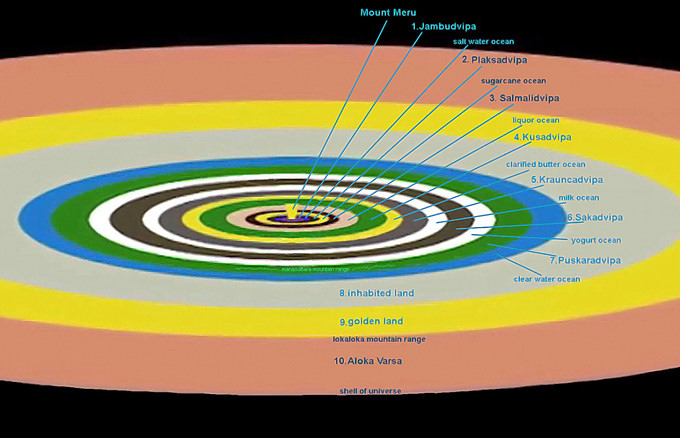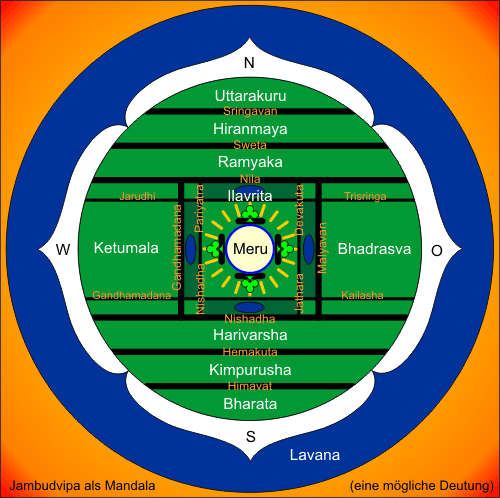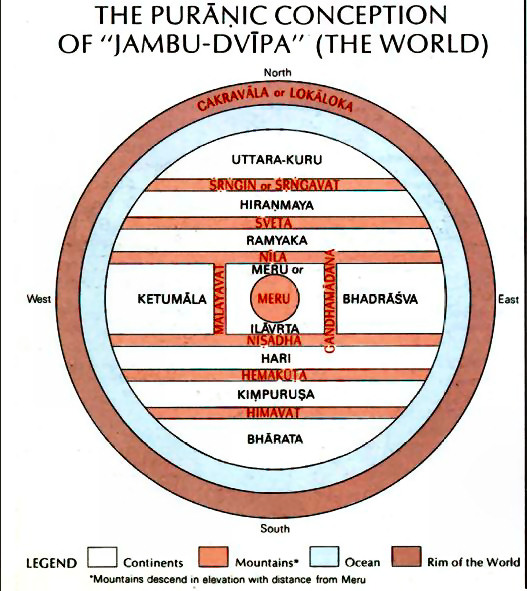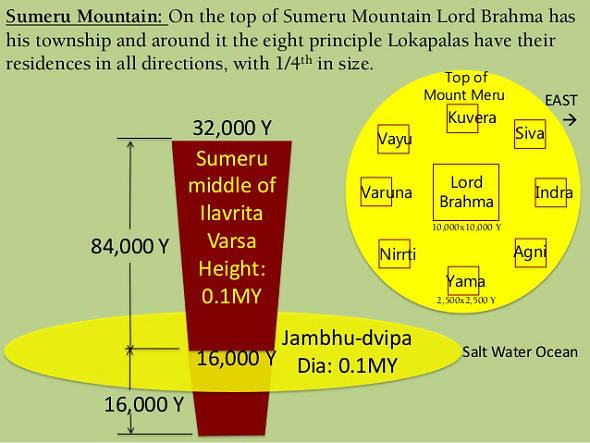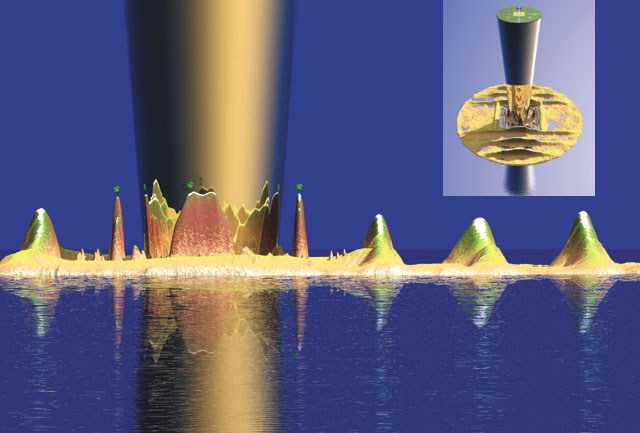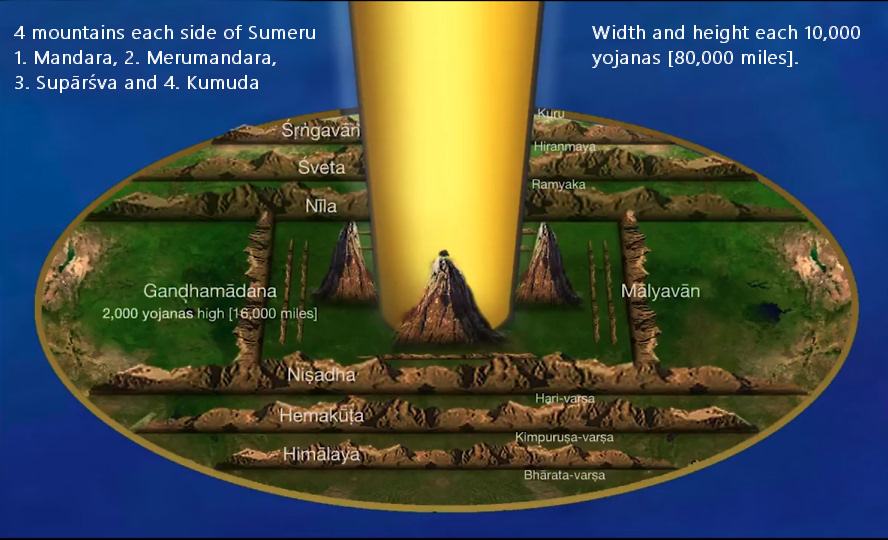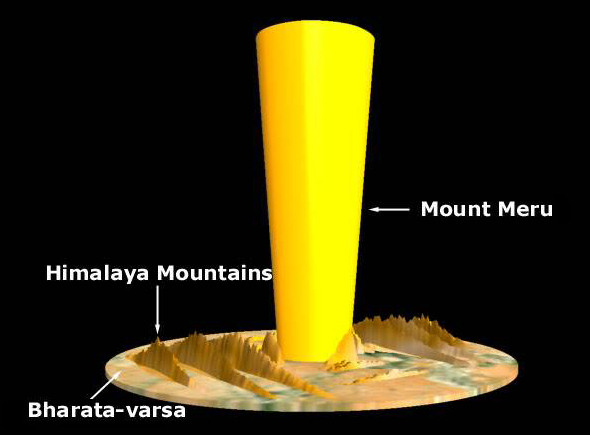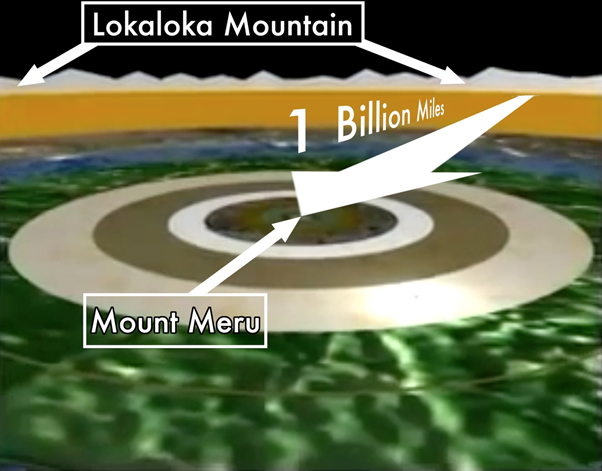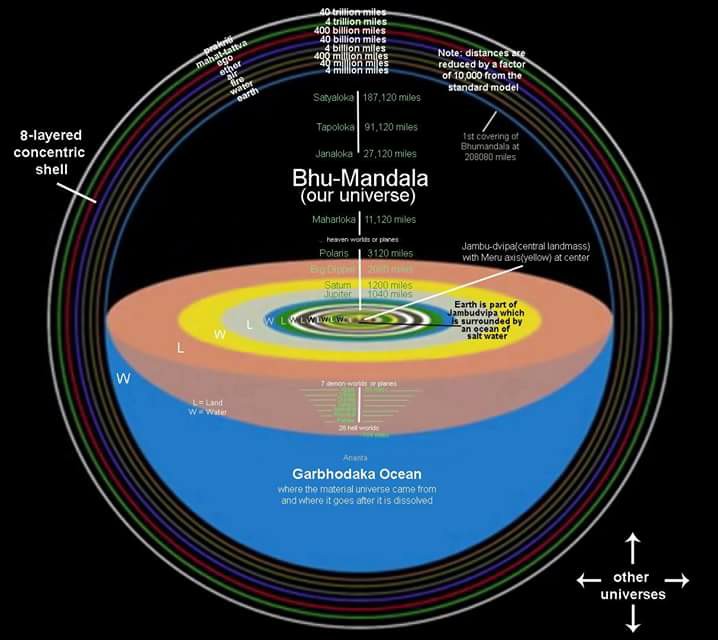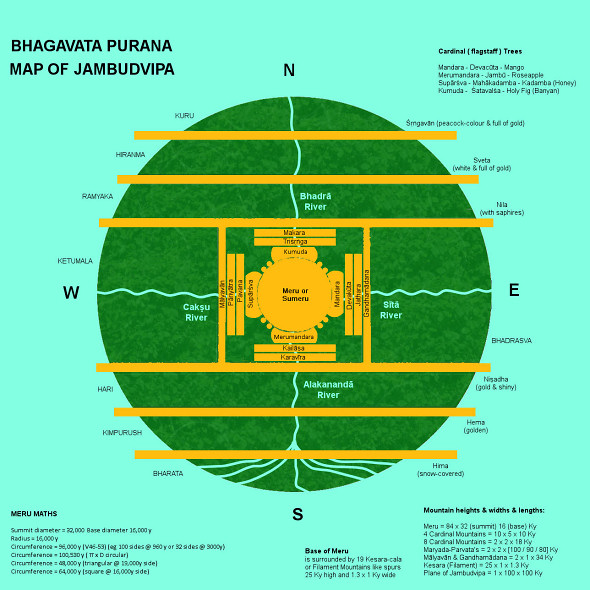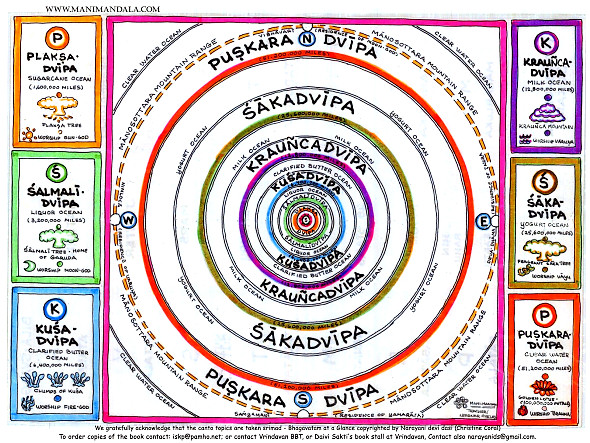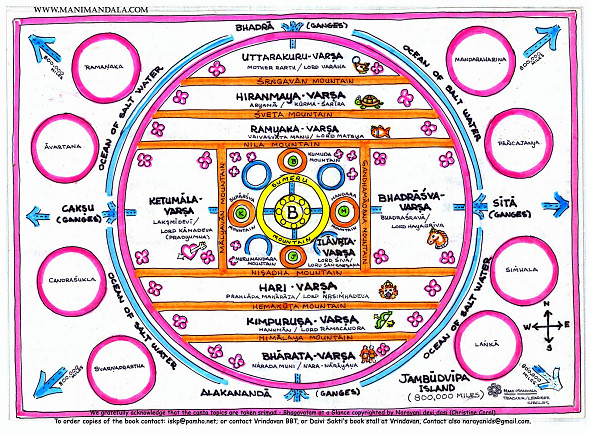![]()
SAILING TO JAMBŪDVĪPA
What's Below the Earth? — The Base of Mount Meru
BY: MAYESVARA DASA
Nov 10, 2017 — IRELAND (SUN) —
Part Two: The Base of Mount Meru
In Part One of this series of papers we looked at the seven subterranean realms within the Earth that go down down for 560,000 miles below the surface. In this Part Two we will look at the depth of Mount Meru below the Earth's surface, but in the context of two related issues:
(1.1) Mount Meru
(1.2) The Size of the Earth (Bhu-gola/Bhu-mandala)
(1.3) The Three Dimensional Universe
Although we have looked at topics 1.2 and 1.3 in previous papers, I will re-present the arguments here in the present context of a discussion on Mount Meru. I wish to repeat the arguments here because there has been a consistent failure on the side of those writing and lecturing on the topic of Vedic cosmology to appreciate the description of the Bhu-mandala Sas a description of reality. The Srimad-Bhagavatam's description of the Earth (Bhu-mandala) has so far been treated more as an intellectual concept or curiosity—a concept without any immediate relevance or consequence to our present way of thinking about the otherwise seemingly unquestionable and unchallengeable idea that the Earth is a globe in space. We wish to impress upon the reader the very opposite conviction, namely that the Earth described in Srimad-Bhagavatam is a description of reality with profound implications and challenges to our present understanding of the Earth we live upon. Is the Earth a small globe-shaped planet in space, or is our Earth area (as described in Srimad-Bhagavatam) part of a much greater Earth that forms a huge circular landscape spanning the center of the universe? This question is set to become a historic controversy that will inevitably affect the world-view of the entire Hare Krishna movement, and eventually the rest of the world.
The shape of the Earth is a very big deal, especially now since the Srimad-Bhagavatam'sversion is to be presented to the rest of the world via the Mayapur Temple of Vedic Planetarium. The Earth described in Srimad-Bhagavatam is completely different from what we've been presented by the modern education system and media, and this obviously presents a very big challenge to the belief system of the devotee community who have grown-up believing (like everyone else) that we live on a globe-shaped planet. The description (or revelation) of the Earth contained in Srimad-Bhagavatam marks the beginning of a new spiritual paradigm, regarding our beliefs about the size, nature, and purpose of the Earth we live upon. But will the present generation of leaders of the International Society for Krishna Consciousness be willing or capable of making the transition from a belief system implanted by scientism (that the Earth is a small globe-shaped planet floating in space), to that offered by Srimad-Bhagavatam—that the Earth is an immense, vast circular plane, and that our own Earth area is surrounded by more lands and more oceans that have yet to be discovered? It will undoubtedly be a test of faith for many devotees.
Bhumandala - the shape of the great round flat Earth circle with all the Dvipas
We previously wrote a paper to the devotee community, and specifically to the gurus and GBC of ISKCON, requesting that they look at this question of the Earth philosophically, and not participate in a culture of dogmatism simply out of obligation to an official party line. The paper can be found here.
Why is the shape of the Earth a big deal? The big deal is that we should live in a paradigm of the Earth as Krishna has created it, not in a paradigm created by speculating scientists beginning with Copernicus and propagated by space agencies such as NASA who have presented the world with images of the so-called Earth globe. The issue of the Earth is so huge that it can topple the whole culture of scientism which has been built and upheld over the last few hundred years on the three greatest falsities ever told—that the universe was created from a big bang, that we evolved from matter, and that we live on a globe! The big deal is that we have been presented false information regarding not only the creation and purpose of the Earth, but also false information regarding the shape and scale of the Earth. The Mayapur Temple of Vedic Planetarium (TOVP) is meant to change all of that by presenting the Earth as it is described in Srimad-Bhagavatam—a vast circular plane with other lands and people surrounding our own. The issue is whether the TOVP will end up just propagating the same false information that our Earth is an isolated globe in space; and that the rest of the Bhu-mandala is somewhere in dimensions beyond our comprehension and concern.
Puranic Jambu-Dvipa - with the nine varshas, mount Meru in the center
(1.1) MOUNT MERU
Continuing from part one with our discussion about the seven subterranean realms, acharya Giridhara Lala in his commentary to SB 5.24.7 (see verse below) mentions that the entrance to the subterranean worlds begin not immediately below the Earth's surface but at a distance of 16,000 yojanas (128,000 miles). This is because the base or root of Mount Meru actually goes into the depths of the Earth itself. Mount Meru is 800,000 miles high, but 672,000 miles are above the surface of the Earth and 128,000 miles are below the surface of the Earth. This is described by Sukadeva Goswami in the following verse:
"Amidst these divisions, or varshas, is the varsha named Ilavrta, which is situated in the middle of the whorl of the lotus. Within Ilavrta-varsha is Sumeru Mountain, which is made of gold. Sumeru Mountain is like the pericarp of the lotuslike Bhu-mandala planetary system. The mountain's height is the same as the width of Jambudvipa—or, in other words, 100,000 yojanas [800,000 miles]. Of that, 16,000 yojanas [128,000 miles] are within the earth, and therefore the mountain's height above the earth is 84,000 yojanas [672,000 miles]. The mountain's width is 32,000 yojanas [256,000 miles] at its summit and 16,000 yojanas at its base." (SB 5.16.7)
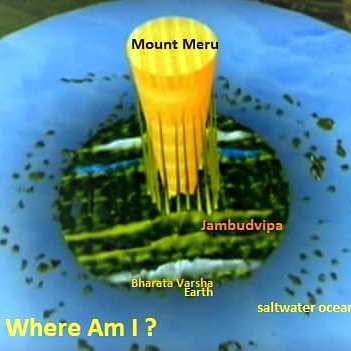
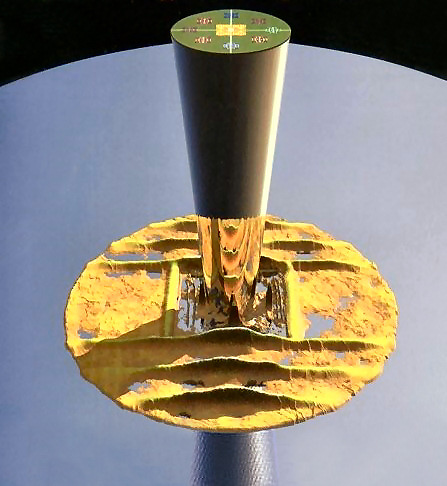
Here it states that Mount Meru stands 672,000 miles above the Earth and it's base goes down into the depths of the Earth for 128,000 miles. To this we have to add the depths of the subterranean realms:
"The bottom of Meru Mountain has sunk 16,000 yojanas [128,000 miles] into the Earth. 10,000 yojanas [80,000 miles] below Earth means 10,000 yojanas [below the 16,000 yojana level]. Actually it will be 26,000 yojanas from the surface of the Earth. Each of them is 10,000 yojanas [80,000 miles] high and wide. They form part of Bhu-loka as it is said in the first canto of Srimad-Bhagavatam, i.e. that Bhu-loka along with the netherworlds are the feet of the virat-purusha [universal form of the Lord]." (Commentary by Giridhara Lala to SB 5.24.7)
Here the acharya is saying that the bottom of Mount Meru penetrates 16,000 yojanas (128,000 miles) into the Earth, and that the first of the seven subterranean realms begin after this bottom point of Mount Meru. He is explaining here that the first of the seven nether-worlds or subterranean heavens (bila-svarga) is 10,000 yojanas (80,000 miles deep) and that each of the seven realms are of a similar height and width (this gives a combined depth of 560,000 miles). He states that all seven of the subterranean worlds are to be regarded as part of the Earth (Bhu-loka). As we explained in the previous paper, the subterranean worlds are not separate planets below the Earth, but are actually colossal underground realms within the depths of the Earth itself, (hence forming part of Bhu-loka).
When we calculate the vast size of Mount Meru's depth within the Earth (128,000 miles) along with the combined size of the subterranean heavens (560,000 miles), it is once again quite obvious that the Bhu-gola being described by Sukadeva Goswami is not some so-called tiny Earth globe spinning in space. Why then are the TOVP representatives insistent on identifying the name Bhu-gola with the so-called Earth globe?
We have just read that Mount Meru is 800,000 miles in height (672,000 miles are above the surface of Bhu-gola and 128,000 miles are below the surface of Bhu-gola). Sukadeva Goswami specifically invokes the name Bhu-gola when he begins his description of the names, measurements, and characteristics of the Earth which, of course includes Mount Meru in the center.
Jambudvipa - with the nine varshas and separating mountains, Sumeru mountain in center
Sukadeva Goswami begins his epic discourse on cosmology with the following words: bhu-golaka-visesaà nama-rupa-mana-laksanato vyakhyasyamah: "O King, I shall nevertheless try to explain to you the principal regions, such as bhu-golaka [Bhuloka], with their names, forms, measurements and various symptoms." (SB 5.16.4). Scrupulous attention to measurements and characteristics of Bhu-mandala as provided by Sukadeva Goswami should be the order of the day. The models for the Planetarium should not only accurately depict the measurements of the the virat-rupa (Krishna's form as the universe), but the preaching about the nature of the Earth should be aligned with Sukadeva Goswami's description. Obviously, Sukadeva Goswami is talking about a very big Earth! Nevertheless, in complete disregard of this very big Earth concept, verses from Surya-siddhanta are cited by those discussing the issue as positive proof for the existence of the Earth globe concept in the Vedic literature; for example:
"aneka ratnanicayo jamvunadamyo girih/
bhu-gola madhyago merurubhayatra vinirgatah//34//
"In the middle of the earth-globe and protruding out (vinirgata) on both sides, is Mount Meru adorned with the river Jambu and bedecked with myriads of jewels" (SS 12.34)
In the above verse, the name Bhu-gola has been translated as 'Earth globe.' For many devotees, simply finding an English translation of the Surya-siddhanta (by a translator who is clearly not familiar with the nature of the Vedic conception of the Earth) is enough to win an argument. The above English translation of Surya-siddhanta was made by the Reverend Ebenezer Burgess in 1860. It is clearly a wrong translation because as described by Sukadeva Goswami, the Bhu-gola is measured at a whopping 4 billion miles in diameter and spans the entire center of the universe (see section 1.2 below: What Size is the Earth?) What Sukadeva Goswami describes as Bhu-gola is certainly not a small Earth globe, but rather, a very large Earth circle.
Why has the above verse from Surya-siddhanta been presented as evidence of an Earth globe by those who should know better? Since Mount Meru is 800,000 miles tall and situated on the island of Jambudwipa which is 800,000 miles in diameter, how could this verse possibly be a description of the so-called Earth globe? The name Bhu-gola is obviously referring to a very different conception of the Earth than our common understanding of the Earth as a globe. Why do those arguing in favour of the Earth globe model not correct their position when the obvious flaw in the argument has been pointed out? Why do we have to endure other devotees who continue to repeat the same bogus arguments regarding the use of the name Bhu-gola to support the idea of an Earth globe?
If Surya-siddhanta is a bona-fide Vedic scripture then it cannot be describing a different Bhu-gola from that described in Srimad-Bhagavatam. Bhu means Earth, and gola can mean circular as well as round. The Vedic 'round Earth' is circular like a roundabout, not round like a globe. That is very clear from the description of the Bhu-gola's measurements and characteristics (see 1.2 below).
Despite differences in details, in essence the Vedic scriptures are not in contradiction to each other. Srimad-Bhagavatam, however, is regarded as the supreme authority over all, being the cream or essence of all the Vedas and thus regarded as the conclusive authority: sarva-vedetihasanam saram (SB 1.3.41). The description of the Earth as a vast circular plane spanning the center of the universe is described in all the Puranas, and it is this conception that must be borne in mind when we come to reading astronomical texts like Surya-siddhanta—particularly when we find a name like Bhu-gola mentioned. One has to understand Bhu-gola as it is described in Srimad Bhagavatam and the other Puranas; one cannot simply displace the Srimad-Bhagavatam's conception of the Earth as a vast circular plane held up by Ananta-sesha, with one's own conditioned idea that the Earth is a round globular planet floating in space and held up by gravity. That is not the concept of Earth described by Sukadeva Goswami; so why introduce a foreign idea and call it Vedic cosmology when it is nothing of the sort?
The confusion in translating the name Bhu-gola from books like Surya-siddhanta arises because (1) the translator is either not following, or has no faith in the Vedic understanding of the Earth based on the original description of the Bhu-gola provided in the Puranas, and particularly from Srimad-Bhagavatam; (2) The translator is simply superimposing their own assumed and preconceived idea of a small round Earth globe onto the Vedic conception of a massive round Earth circle (Bhu-gola/Bhu-mandala).
In the above verse from Surya-siddhanta we read that Meru is in the middle of the Earth (bhu-gola madhyago merurubhayatra) which is where we find it described in Srimad-Bhagavatam. So far so good! But what size is Meru? We have just read in the verse above (SB 5.16.7) that Meru is 800,000 miles high; 128,000 miles of the Mountain is below the Earth's surface and 672,000 miles are above the surface. Could a globe of 24,900 miles possibly accommodate such a size? Has anyone seen a golden mountain standing 672,000 miles above the surface of the Earth?
So this tells us one or the other must be true: either Srimad-Bhagavatam's description of the great Earth circle is completely mythological, or else we've all been fooled into believing that the Earth is a globe.
Personally, I have faith in Srimad-Bhagavatam's version:
"Therefore, as indicated in Srimad-Bhagavatam by Sukadeva Gosvami, we should not try to comprehend the greater mountainous areas of the universe merely by our calculations. Sukadeva Gosvami has already stated that such calculations would be very difficult even if one had a duration of life like that of Brahma. We should simply be satisfied with the statements of authorities like Sukadeva Gosvami and appreciate how the entire cosmic manifestation has been made possible by the external energy of the Supreme Personality of Godhead. The measurements given herein, such as 10,000 yojanas [80,000 miles] or 100,000 yojanas [800,000 miles], should be considered correct because they have been given by Sukadeva Gosvami. Our experimental knowledge can neither verify nor disprove the statements of Srimad-Bhagavatam. We should simply hear these statements from the authorities. If we can appreciate the extensive energy of the Supreme Personality of Godhead, that will benefit us." (Purport SB 5.16.10)
One way to understand the presence of an 800,000 mile golden mountain standing in the center of the Earth is simply by considering that our present conception of the Earth is wrong. One must take time to consider the new paradigm presented by Srimad-Bhagavatam—that the Earth is not a globe in space, but rather, it is a massive circular plane. We don't see Meru from our position in Bharata-varsha because the distance along the Earth plane from the southern tip of Bharata-varsha to the center of Mount Meru is 400,000 miles away. The law of perspective (the vanishing point on the horizon line) does not allow one to see things in the distance, no matter how large they are. A question may arise then as to why we don't see photos from outer space of this great Earth landscape with Mount Meru in the center. One possible answer is that there are no satellites or astronauts in faraway space that could photograph such a fantastic landscape; to put it bluntly—space travel is a hoax and nothing more than a very expensive movie made-up by NASA and other so-called space agencies. What we call satellites are merely cameras and other types of measuring equipment that are situated in high altitude, not outer space.
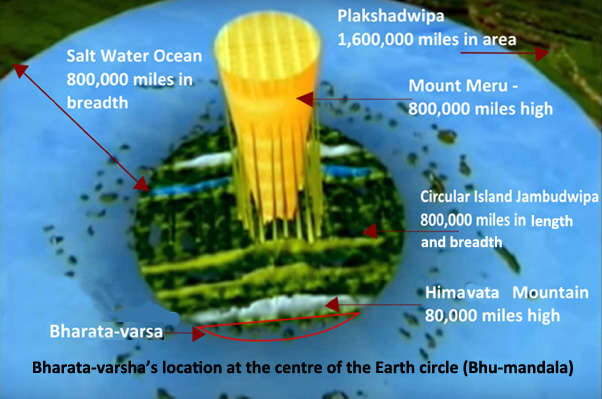
The image above is just a detail of the central island of Bhu-mandala, but even this one island gives some idea of the enormous scale of the Earth. The continents of our known area of the Earth (which are situated somewhere in the region of Bharata-varsha) are actually just a speck in the overall land-mass of the vast plane of the Bhu-gola in question. I have been repeating these images and descriptions of Bhu-mandala through-out this series of papers only so that devotees can become familiar with the Earth as it is described by Sukadeva Goswami; my apologies for anyone who finds this tiresome. The above image shows only the central island of Bhu-mandala with Bharata-varsha to the south, and surrounded by the enormous salt-water ocean (our salt-water oceans are just a tiny drop of the complete salt-water ocean which is 800,000 miles in breadth). The other six islands and oceans of Bhu-mandala (not featured here) continue for over 200 million miles. The seven islands of Bhu-mandala form the inhabited area of the Earth circle where billions of other humans are living in varied civilizations. Srimad-Bhagavatam obviously describes a very different picture of reality from that presented by NASA.
Buddhist Meru-Mandala
As the Mayapur Temple of Vedic Planetarium rises, it is incumbent upon the followers of Krishna to investigate the true nature of the Earth they stand upon. Such an investigation can begin by first understanding the description of the Earth contained in Srimad-Bhagavatam. Whatever one has been led to believe about the nature of the Earth, we should, at least, start thinking about the subject by understanding our own shastra correctly. By correctly understanding the description of Bhu-mandala in Srimad-Bhagavatam, we are more spiritually prepared to begin an investigation into the claims of the official science and government propaganda in support of the Earth globe concept. Such an investigation is already well under way by a practical overnight internet revolution against the science supporting the globe concept, along with continued exposes of so-called space agencies such as NASA and ESA. It is very interesting that this revolution in thinking about the Earth and the cosmos arose almost spontaneously in 2015 in conjunction with the construction of the TOVP.
(1.2) THE SIZE OF THE EARTH
The name Bhu-gola is found in Srimad-Bhagavatam and is considered evidence for the idea of a round or globe-shaped Earth. However, since the Bhu-gola in question is described as being 4 billion miles in diameter with an 800,000 mile golden mountain at it's center, the obvious conclusion is that the name Bhu-gola cannot be applied to the so-called Earth globe of 24,900 mile circumference that supposedly floats in space. No such conception of an Earth globe floating in space exists in the Puranas; it is a foreign idea that has been superimposed unto the Vedic conception. To be clear on this, let us look again at the measurement of Bhu-gola.
Chapters 16-20 of the Srimad-Bhagavatam's fifth canto are a description of the measurements and principal characteristics/features of the Bhu-mandala, otherwise called Bhu-gola. In fact, the very name Bhu-gola is invoked in the verse below that describes the complete size of the Earth. After describing these seven islands and other features of Bhu-mandala up to the point of Lokaloka Mountain, Sukadeva Gosvami summarizes his description in SB 5.20.38:
"Learned scholars who are free from mistakes, illusions and propensities to cheat have thus described the planetary systems and their particular symptoms, measurements and locations. With great deliberation, they have established the truth that the distance between Sumeru and the mountain known as Lokaloka is one fourth of the diameter of the universe—or, in other words, 125,000,000 yojanas [1 billion miles]." (SB 5.20.38)
Bhumandala - the shape of the Earth
Herein Sukadeva Goswami states that learned scholars who are free from mistakes, illusions, and propensities to cheat, have calculated that the distance from Mount Meru to Lokaloka Mountain is 125,000,000 yojanas (1 billion miles), which is a quarter of the overall size of Bhu-gola. Mount Meru is a golden mountain at the very center of Bhu-gola; and Lokaloka Mountain is a billion miles away along the vast Earth plane. Lokaloka is the most prominent feature on the Bhu-mandala and it is so huge that it blocks the sunlight from going to the outer reaches of the Earth. The dark area of the Earth is called aloka-varsha. The point made here by Sukadeva Goswami is that since one billion miles is a quarter of the Bhu-gola, then it's complete diameter is 4 billion miles. The Sanskrit and English synonyms for this part of the verse are:
pancashat-koti—500,000,000 yojanas; ganitasya—which is measured at; bhu-golasya—of the planetary system known as Bhugolaka; turiya-bhagah—one fourth; ayam—this; lokaloka-acalah—the mountain known as Lokaloka.
This is further confirmed in the commentaries by the acharyas from Commentaries on 5th Canto Bhagavatam Cosmology by Vaisnava Acaryas edited by Danavir Goswami:
"To facilitate the knowledge of the height and width of the mountain, the dimension of the earth is first mentioned here. The learned say that the Earth is 500,000,000 yojanas [4 billion miles]. (Commentary by Viraraghava, SB 16.20.38)
The celestial sphere and the terrestrial sphere [vertical and horizontal spheres are both 500,000,000 yojanas [4 billion miles] in width. A fourth of it will be 125,000,000 yojanas [1 billion miles]. (Commentary by Vishvanatha Cakravarti Thakura, SB 16.20.38)
The extent of the entire Earth is known to be 500,000,000 yojanas [4 billion miles] by great people. A fourth of it will be 125,000,000 yojanas [1 billion miles]. (Bhagavatprasadacarya, SB 16.20.38)
In the verse quoted above (SB 16.20.38), Sukadeva Goswami gives the measurement from Mount Meru (the center of Bhu-gola or Bhu-mandala) to Lokaloka mountain as 1 billion miles (or a quarter of the overall diameter of the universe). Now since this one area of Bhu-gola is 1 billion miles which is a quarter of the overall diameter of the universe (4 billion miles), the Bhu-gola cannot possibly be referring to a so-called Earth globe floating in space with an alleged circumference of only 24,900 miles. In addition, since the seven islands and their surrounding oceans stretch for hundreds of millions of miles across the vast horizontal plane of the Bhu-gola, they cannot be referring to the continents of our Earth. In other words, it is simply wrong to think that the word Bhu-gola is referring to, or describing, a small round globe in space such as that presented by NASA in their photos of Earth from so-called outer space. Thus, Bhu-gola cannot possibly be equated with, or identified as the assumed Earth globe of 24,900 miles circumference. No description of a small Earth globe is actually given in any of the 18,000 verses of Srimad-Bhagavatam or in any other Purana. Such an entity simply does not exist in the Vedas, and as we have argued in previous papers, does not exist at all.
The verse quoted above (SB 16.20.38), and the subsequent commentaries by the acaryas, clearly state that learned scholars (kavibhih) describe the Earth (Bhu-gola) as 4 billion miles in diameter; a quarter of this distance (from Mount Meru to Lokaloka Mountain) is 1 billion miles. In his translation Srila Prabhupada qualifies the word learned scholars (kavibhih) as those who are free from 'mistakes, illusions and propensities to cheat.' This is an interesting qualification, and particularly in relation to the verse in question. It is, therefore, simply unacceptable that respectable disciples of Srila Prabhupada such as Rajashekhara dasa, Gaura-gopal dasa, Danavir Goswami etc., as well as representatives and defenders of the globe model within the TOVP, continue to propagate this false notion that Bhu-gola refers to a supposed Earth globe—despite having the truth of the matter having been brought to their personal attention on a number of occasions. I offer my respects to all these devotees, but I must insist on requesting them to preach accurate information. One may continue to present arguments in favour of the idea that the Earth is a globe if that is what you believe, but clearly the use of the name Bhu-gola cannot be included as one of them.
By presenting a few statements from Srila Prabhupada equating Bhu-gola with a round Earth, these supporters of the globe maintain a seeming loyalty to Srila Prabhupada, whilst, in fact, completely ignoring Srila Prabhupada's consistent and insistent statements to follow the version of Srimad-Bhagavatam. The above verse conclusively establishes that Srimad-Bhagavatam defines and describes as Bhu-gola as a 4 billion mile circular plane. So how can anyone continue to argue that the name Bhu-gola is a reference to the supposed Earth globe of 24,900 mile circumference?
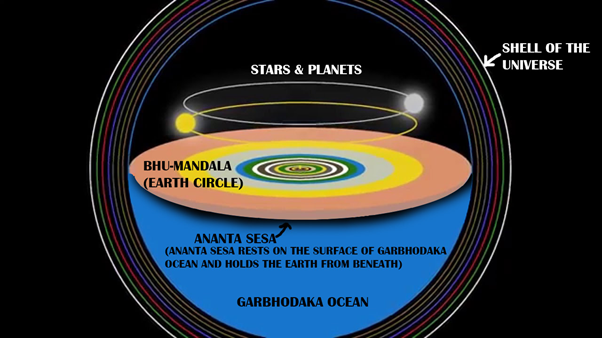
Srila Prabhupada's use of English language is very interesting:
"Just try to understand, but don't try to misunderstand." (Speech to Indian Audience Montreal, July 28, 1968)
It would seem a funny thing that someone would want "to try and misunderstand," but that unfortunately is what appears to be happening. Rather than accepting the Srimad-Bhagavatam's clear description of Bhu-gola as a vast circular Earth disc, for some reason devotees 'try to misunderstand' and come up with convoluted arguments to insist that Bhu-gola is referring to a so-called Earth globe. Such attempts are not at all loyal to Srila Prabhupada; in fact, they discredit his own absolute fidelity to Sukadeva Goswami. Srila Prabhupada made a few statements equating Bhu-gola with the supposed 'round Earth' or Earth globe simply because at the time of his preaching, no thorough study or discussion of the fifth canto cosmology had been made. It was Srila Prabhupada's own desire that his disciples 'carefully study the details of the Fifth Canto and make a working model of the universe,' (Letter from Srila Prabhupada to Svarupa Damodara dasa, April 27, 1976)
So taking this instruction to carefully study the details of the fifth canto, we need to back to the original verse describing the measurement of Bhu-gola (see verse SB 16.20.38 cited above). Srila Prabhupada in the word for word synonyms to this verse, the Sanskrit word vicintitah has been translated as 'established by scientific calculations.' The sense is that learned scholars (kavibhih) have arrived at a calculation of the Earth's measurement of 4 billion miles because they have studied the subject with great consideration (vicintitah). The word is also found in the Siksastakam of Sri Krishna Caitanya Mahaprabhu: sthita-dhuli-sadrsam vicintaya 'Kindly consider Me (vicintaya) a particle of dust at Your lotus feet.' (CC Antya-lila, 20.32). The Sanskrit dictionary defines vicint as: 'to think about, to consider, to ponder over, to meditate upon, to take into consideration, to have regard for, to find out, to discern, to discover, to determine, to perceive, to observe.' The use of this word by Sukadeva Goswami is carefully selected and appropriate for the reason that some people (including some members of ISKCON) may try to pass the whole subject of the Bhu-mandala as inconceivable. The Sanskrit word for thinking about something is vicintya. By contrast, one of the Sanskrit words for something that is inconceivable is avicintya. We find the word used, for example, in the Brahma-samhita where it states that without devotion to the Lord, the great thinkers (muni-pungavanam) cannot understand Govinda because He is avicintya-tattve—beyond material conception (Bs 5.34). In the Caitanya-caritamrta it is described that the Lord has avicintya-shakti inconceivable energies (Adi-lila 7.124). Sukadeva Goswami, however, carefully uses the word vicintya not avicintya in regards to the measurement of the great Earth circle, which means it is something that one can understand by meditating and thinking about the subject. It is not a subject that is inconceivable or incomprehensible. We likewise encourage the members of ISKCON to follow the path of learned authorities by 'thinking' about the subject, and not to be led astray by the false propaganda of unthinking dogmatists trying to convince you that you live on an Earth planet, when you may, in fact, be living on a great Earth plane.
The implications of these huge measurements of the Bhu-mandala were never brought to Srila Prabhupada for his consideration. In the summer of 1977, Srila Prabhupada had asked some devotees to prepare maps of the Vedic cosmos according to Srimad-Bhagavatam in preparation for the display at the Vedic planetarium. At the end of June, a map of Bhu-mandala had been prepared, and some discussion took place over a few days. Even with a map the devotees had not yet come to grips with the enormous implications of what Sukadeva Goswami was describing, and what this meant for the Earth globe:
Devotee (2): Srila Prabhupada, previously we painted in the art department... Just like Varaha lifted the earth, and the earth was a globe, and we showed also a globe of the earth. How does that relate to this? Previously, when we painted, we showed the earth a ball. So now the artists will be very confused. How it fell in the Garbha Ocean as a ball?
Yashodanandana: It depends on what we mean by earth. The Western conception of earth is just five continents and a few oceans, but according to Bhagavatam, earth means Jambudvipa, because earth is connected with Jambudvipa.
Devotee (2): So whole Jambudvipa fell.
Bhakti-Prema: Bhagavata describes the height of Himalayas, eighty thousand miles.
Prabhupada: No, about this Earth globe.
Bhakti-Prema: About the Earth it describes four billion miles.
Tamala Krishna: That means Jambudvipa.
Bhakti-Prema: No, that means complete Earth, four billion miles. That is eight lakhs miles [800,000 miles], Jambudvipa.
Tamala Krishna: Four billion is the universe.
Bhakti-Prema: Bhu-mandala!
Tamala Krshna: Bhu-mandala! Oh, the Bhagavatam describes Bhu-mandala as Earth.
Prabhupada: Oh.
Yashodanandana: Bhumi.
Bhakti-Prema: ...has come right from the ocean, from the bottom of the ocean.
Prabhupada: So explained there. Then this question is solved.
Tamala Krishna: Yes. The whole Bhu-mandala fell.
Bhakti-Prema: So the universe is round, and from bottom of the Garbhodaka ocean to top of Satyaloka there is four billion miles. Then the again, from east to west again is another four billion miles. Because Bhu-mandala is situated in between the earth.
Prabhupada: Explain. He'll explain.
Bhakti-prema dasa rightly points out that the diameter of the Earth is four billion miles, and that it was the entire Bhu-mandala (not some so-called Earth globe) that fell into the Garbhodaka Ocean. He also corrects the misunderstanding of Yasodanandana Prabhu and Tamala Krishna Goswami regarding Jambudwipa. Jambudvipa is the name of the central island of Bhu-mandala, not the name of the Earth itself. Unfortunately, the following conclusion didn't arise: since the Earth is 4 billion miles, and the central island of Bhu-mandala is Jambudwipa which is 800,000 miles, then Bharata-varsha (which is part of the island of Jambudwipa) cannot be a separate globe-like planet floating in space. From the description, Bharata-varsha is just a tiny area that is situated on the Earth's massive plane; it is not a planet floating in space.
This line of reasoning was never put to Srila Prabhupada for his consideration. The devotees involved here at not at fault as the process of inquiry into the nature of Bhu-mandala was really only beginning, and it was already late in the day: Srila Prabhupada entered samadhi just a few months later without any resolution as to the nature of the Earth and our place upon it.
We should faithfully accept that Sukadeva Goswami is providing the real measurements and characteristic features of the Earth (Bhu-gola). If Krishna is real, then the Earth of Srimad-Bhagavatam is real, which obliges everyone in ISKCON to at least consider the possibility that the globe idea is based on either ignorance/speculation on the part of scientists such as Copernicus, Galileo and Newton, etc., as well as deliberate falsehood on the part of NASA and other space agencies. It also requires that we calmly discuss what Srila Prabhupada himself about the Earth.
Srila Prabhupada, for example, sometimes referred to Bhu-gola and even Bharata-varsha as the Earth globe, but Bharata-varsha, is just part of the Bhu-gola; it is not the Bhu-gola itself. Bharata-varsha is located in the southern side of Jambudwipa, the central island of Bhu-gola. Bharata-varsha is located just a few hundreds thousand miles south of Meru:
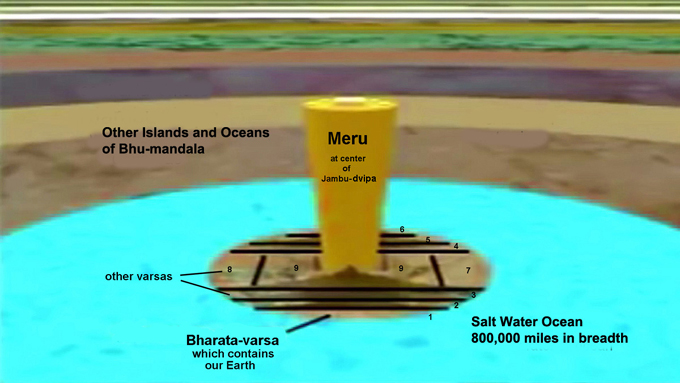
Bharata-varsha is thus on the same landscape as the rest of the great Earth circle, it is not a separate planet in space. Our own continents are just a tiny part of Bharata-varsha. Bharata-varsha is not just a name for India, or even of the continents of our known Earth area. Bharata-varsha is one of the nine varshas or divisions of Jambudwipa, and is also of enormous size covering hundreds of thousands of miles. This context must be borne in mind when we consider all of the earlier statements and translations from Srila Prabhupada wherein he equates Bharata-varsha with the so-called Earth planet:
"This Earth planet is known as Bharata, or Bharata-varsha" (SB 1.12.20)
"...after whose name this planet Earth was called Bharata-varsha." (SB 2.7.10 Purport)
In the absence of a map of Bhu-mandala, the word 'planet' was simply Srila Prabhupada's default word for describing any place in the universe; but strictly speaking Bharata-varsha (as described by Sukadeva Goswami) is not a planet. Bharata-varsha is literally that—a varsha! A varsha is a division in a landscape caused by mountains. Bharata-varsha, therefore, is simply one of the nine divisions/regions/areas on the super-continent known as Jambudwipa. It is the varsha named after Bharata, the eldest son of Lord Rsabhadeva (SB 11.2.17). So Bharata-varsha is just a part of Jambudwipa (the central island of the Great Earth plane) and not a separate Earth planet in space. Again, it requires acceptance of the Bhagavatam's conception of the Earth in order to accommodate the idea, but that is what Srila Prabhupada expected of us—to believe in Srimad-Bhagavatam! Srila Prabhupada's use of the word 'planet' is understandable considering the circumstance, but what excuse is there for those supposedly studying the subject and who should know better? Despite the now clear description of Bharata-varsha's location on the plane of the Earth circle, there are devotees writing and lecturing on this subject who nonetheless, continue to propagate the false idea that Bharata-varsha is the so-called Earth planet floating in space. Why do this?
Map of Jambudvipa
Yes, Srila Prabhupada referred to Bharata-varsha as a planet, but it was for reasons already stated in previous papers: until June of 1977, Srila Prabhupada had no map of the Bhu-mandala, and hence Bharata-varsha's position on the Earth plane was unclear. When eventually a map of Bhu-mandala was produced and questions about the contradictions between the modern and Vedic conceptions of the Earth arose, Srila Prabhupada did not give a direct answer to the question of the Earth's shape, but his unequivocal instruction was for his disciples to understand and present Srimad-Bhagavatam's cosmology exactly as it is described:
Prabhupada: We do not require to satisfy the scientists. We have to describe according to our book. That's all. If they can understand, let them understand. Otherwise... It is not our business to satisfy the so-called scientists. We are giving the real description. (Room Conversation, June 18, 1977, Vrindavana)
We have discussed in previous papers that apart from speaking on a few particular instances (such as questions regarding the moon), the ins and outs of Vedic cosmology was not an area of the spiritual science where Srila Prabhupada considered himself as a learned authority. In the area of Vedic cosmology and its presentation within the TOVP, Srila Prabhupada (guru) re-directed the research to his disciples (sadhus) whom he requested to study the fifth canto (shastra) and present a working model of the universe:
Carefully study the details of the Fifth Canto and make a working model of the universe,' (Letter from Srila Prabhupada to Svarupa Damodara dasa, April 27, 1976).
In other words, if we are to follow the statements of guru, sadhu, and shastra on this issue of the Earth, the gurus instruction on Vedic cosmology was for his disciples to study the fifth canto and work it out; not that guru necessarily had all the answers:
Yasoda-nandana: Prabhupada, what is the shape of this tiny portion of earth or whatever place we are on? What is the shape of this, whatever you call...
Prabhupada: Ask them. Why don't you ask them? Sometimes they say flat, sometimes they say it is round. Why don't you ask them, the scientists?
Yasoda-nandana: We don't accept what they say.
Prabhupada: No, no. Formerly they were under the impression the world is flat. And now they are saying round. So what they'll say after few years?
Yasoda-nandana: They are not consistent. That's a fact. They're very inconsistent in their theories.
Prabhupada: Ask them which is correct. "Probably" this is correct.
Bhakti-prema: When someone asks this question, first one would reply.
Prabhupada: I answered it. You people say like that, so which is correct? Flat or round?
Tamala Krishna: They will say "What does the Bhagavatam say?"
Prabhupada: Huh?
Tamala Krishna: They may reply to us, "All right, we are rascals. So please tell us what is the fact."
Prabhupada: That is, we are...
Tamala Krishna: That's what he's asking. What should be shown? Actually we're a little stumped by... I mean...
Prabhupada: Yes, you must have proper answer as far as possible.
Tamala Krishna: We just read... We got a version from South India, and we've even found that there are different conceptions of what the Bhagavata is saying. But the Puranas, they give some Puranic references.
Bhakti-prema: It is written the world... The earth is round and flat.
Prabhupada: Hm?
Bhakti-prema: Earth is round and flat both, together.
Prabhupada: Yes.
Bhakti-prema: First we should reply it is acintya. This should be the reply. "Inconceivable."
Yasoda-nandana: If it is inconceivable, then they will say how we can conceive it?
Prabhupada: Take the version of Bhagavatam...
...we have to accept shastra.
(Discussions about Bhu-mandala, July 5 1977, Vrindavana)
Here Bhakti-prema dasa says that the Earth is round and flat together which, of course, is the accurate description. Bhu-mandala is round and flat taking the form of a huge circular plane that crosses the center of the universe.
Bhu-mandala - with all the Dvipas, Jambu-dvipa in the center
The important point here is that Srila Prabhupada's answer to questions about the Earth was to find the answer in Srimad-Bhagavatam; his insistence is on following Srimad-Bhagavatam. Who then can cite a Sanskrit verse from Srimad-Bhagavatam that describes our Earth as a small planet floating in space? Such a verse doesn't exist in Srimad-Bhagavatam for the simple reason that Bharata-varsha is where Sukadeva Goswami describes it—at the southern side of Jambudwipa (the central island of the Earth plane). Bharata-varsha is not floating in space, it is on the plane of the great Earth circle, specifically at the southern side of Jambudwipa.
Jambudwipa - the great round flat earth plane with Bharata-varsha on the south
Since Srimad-Bhagavatam describes Bharata-varsha as part of Jambudwipa, what is the practical relevance of that information for us here in Bharata-varsha? It means that our world (according to Srimad-Bhagavatam) is part of a greater Earth flat plane that is surrounded by more land and more ocean. This is the world-view of Srimad-Bhagavatam and it is this world-view that is meant to be presented via the TOVP as a factual reality. The Earth of Srimad-Bhagavatam is a revolutionary world-view, not some quaint intellectual concept conveniently rubber-stamped and pigeon-holed as 'Vedic cosmology,' but without any relevance or challenge to our self-assured belief that we are hovering though space on a so-called Earth globe. People are in complete darkness regarding their situation in the universe and it is this ignorance that is meant to be dispelled by the revelation of Srimad-Bhagavatam and it's presentation within the Mayapur Temple of Vedic Planetarium. As a follower of Srimad-Bhagavatam I accept and am convinced of the idea that the continents of Earth must be resting on the great horizontal plane of Bhu-mandala, and that they do not curve around a globe-shaped planet that is supposedly floating in space. Empirical science at least validates that we live on a flat plane (there is no observable measurable curvature to the Earth). As yet, the karma does not allow for the discovery of other lands surrounding our own, but the existence of other lands is to be ascertained from Srimad-Bhagavatam. This is the message that I believe should be presented to the world via the TOVP.
Such a presentation, of course, involves exposing the fraudulent science and politics that has led to the creation of a 'global' mindset where the people of the world now believe they are on a globe-shaped planet flying through godless dark space. This will take time to establish. The problem, of course, is that most of the devotees in ISKCON (like everyone else in the world), have been educated and conditioned into believing that the Earth is a globe; and it's difficult, of course, to overcome belief in such a powerful icon as the Earth globe:
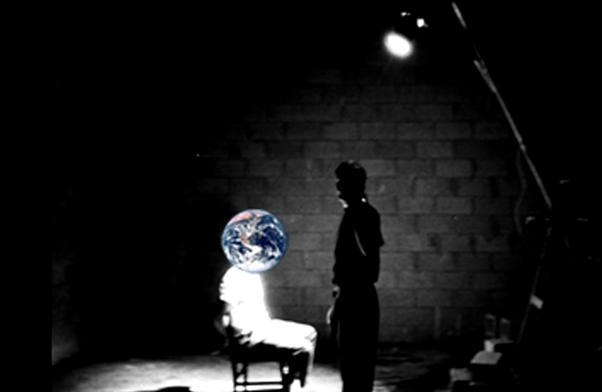
Even within the Vedic culture, knowledge of the Bhu-mandala had been covered over, so we have no strength of tradition to draw upon. As discussed above and in previous papers, Srila Prabhupada did not specifically preach about the Srimad-Bhagavatam's description of the Earth because a full study of the fifth canto cosmology had not been made by the time of Srila Prabhupada's departure in November 1977, and thus the concept of Bhu-mandala had not been sufficiently clear. This is evident from the Bhu-mandala discussions. It is equally evident from the Bhu-mandala discussions of June/July 1977 that Srila Prabhupada was now well aware of the glaring differences between the two world-views; therefore, he emphasized to his disciples over and over again to present the version of Srimad-Bhagavatam. We have discussed the issue in this paper (section 1.2).
The conclusion of the Bhu-mandala discussions is that after some initial discussion on the issues raised about the Earth and related issues of Vedic cosmology, Srila Prabhupada basically left his disciples to work it out:
"And during the summer of '77, Prabhupada had a lot of meetings with him and Tamala Krishna Maharaja to discuss how to do this Vedic Planetarium. And they actually sent people out, and they tried to get people from South India; there was a lot of effort that was made, you know, to try to get a good concept of how to present it. But they couldn't find anybody who was able to do it; at least not to Prabhupada's satisfaction. So it was one of those things that Prabhupada left with us." (Interview with Hari Sauri dasa from Danavir Goswami's Vedic Cosmos documentary)
It is apparent that in the absence of a clear conception of Bhu-mandala, Srila Prabhupada simply spoke of the Earth in conventional terms as a globe or a planet, but his real desire was for his disciples to study the details of the fifth canto and present a working model of the universe as it is described in Srimad-Bhagavatam. An understanding of the Earth is, of course, central to any model. Srila Prabhupada wanted to revive and present knowledge of the Vedic version via the Mayapur Temple of Vedic Planetarium, but there are those who are seemingly not so convinced of the Srimad-Bhagavatam's model. Ironically, those in the TOVP management are particularly entrenched in the 'global' world-view—a world-view that has absolutely nothing to do with what they are meant to be presenting—the Earth according to Srimad-Bhagavatam, not the Earth according to Copernicus, Galileo and Newton! The quick-fix argument is that Srila Prabhupada called the Earth a 'globe' and a 'planet,' and Srila Prabhupada can't be wrong; therefore that's the end of the argument—the Earth is a globe! But that is not the end of the argument, because it is not a question of Srila Prabhupada being wrong; it is a question of Srila Prabhupada requesting us to find out what is right by careful study of the fifth canto.
It is either a lack of knowledge of the subject, or simply a lack of faith in the Earth being described by Sukadeva Goswami that leads one to favouring the Earth presented by so-called scientists and space agencies. The result of this lack of understanding or lack of faith is a series of many convoluted arguments from those members of ISKCON who are bent on trying to reconcile two incompatible conceptions of the Earth and the universe. The result is 'hodgepodge' (to quote one of Srila Prabhupada's favourite words); a mish-mash of ideas that are full of glaring contradictions:
"You have to accept anything from the authorized source. So according to Vedic civilization, all knowledge is received from the Vedas, perfect authorized source. Sruti-pramana, evidence from the sruti, from the Vedas, that is perfect. Therefore, according to Vedic civilization, if you want to establish something you have to quote the section or the injunction from the Vedas, Then it is perfect. In learned circle you cannot say anything hodge-podge. That will not be accepted. If you support your statement from the evidence of the Vedas, then you are accepted as authority." (Bg 16.9, Hawaii, February 5, 1975)
"If you read hodge-podge, then you will not be able to understand. Therefore sadhu. And sadhu means he gives quotation from sastras, authorized sastra He's sadhu. Sadhu will not give anything manufactured by him. No. He's not sadhu. Sadhu means whatever he'll speak, immediately he'll give evidence from the sastra. Sadhu-sastra-guru. And guru means who is following sadhu and sastra." (SB 1.2.7, Vrindavana, October 18, 1972)
Again, I present my challenge is for anyone to cite a Sanskrit verse from Srimad-Bhagavatamthat describes our Earth as a small planet floating in space? The location of Bharata-varsha on the plane of Bhu-mandala is otherwise clearly described in SB 5.16.1-9. One is free to believe what they wish, but for one who has little or no faith in the Srimad-Bhagavatam's description of the Earth, then at least be honest enough to admit it. If one has no knowledge or faith in what Sukadeva Goswami is describing, then please don't earn a livelihood in the TOVP presenting false conceptions of the Vedic Earth; or otherwise try to acquire a name and position in the lecturing circuit by speaking contrary to the truth established by Srimad-Bhagavatam. I'm not accusing anyone of being of such a mentality, or of the mentality described below, but I present the following two verses as a reminder and a cautionary warning:
"Uncultured men will accept charity on behalf of the Lord and will earn their livelihood by making a show of austerity and wearing a mendicant's dress. Those who know nothing about religion will mount a high seat and presume to speak on religious principles." (SB 12.3.38)
vaksyanti—will speak about; adharma-jnah—those who know nothing about religion; adhiruhya—mounting; uttama-asanam—a high seat.
The Earth has a specific nature or dharma (characteristic); if the TOVP present the wrong idea about the Earth that is adharma-jnah. Remember, the TOVP's mandate is not to present the Earth as it is understood by Western cosmology; the mandate is to present the Earth as it is described according to Vedic cosmology—specifically as it is described in Srimad-Bhagavatam's fifth canto. One may personally consider such a description to be either right or wrong, real or fantasy, an amazing revelation or un-scientific mythology, but please let the preaching be based on and reflect Srila Prabhupada's firm faith in Srimad-Bhagavatam'scosmology as a description of a spiritual reality. Srila Prabhupada did not speak against the globe idea because at that time, the Srimad-Bhagavatam's mysterious description of the Earth had not been fully clear. Nonetheless, Srila Prabhupada preached full faith in the Srimad-Bhagavatam's description of the universe as a description of reality, not mythology. Since Bharata-varsha is located in Jambudwipa, then that should be presented as the reality. Unfortunately, within the TOVP management, the Srimad-Bhagavatam's description of our place on the great Earth circle does not appear to be appreciated as a factual reality; otherwise, why are representatives from the TOVP still arguing that the Earth is a globe-like planet floating in space? Yes, the TOVP representatives can produce exhibitions, animated movies, and books describing and depicting the vast expanse of Bhu-mandala and thus claim to be faithfully representing Srimad-Bhagavatam, but do the creators of such images take it seriously? As mentioned, Bharata-varsha is simply part of Jambudwipa, the central island of Bhu-mandala; it is not a separate planet floating in space. Despite Srimad-Bhagavatamdescribing Bharata-varsha as part of the island of Jambudwipa, the TOVP management are insistent on making people believe that Bharata-varsha is a so-called Earth globe floating in space. Does that demonstrate faith in Srimad-Bhagavatam? Why are they presenting this contrary idea when Sukadeva Goswami's description of Bharata-varsha's location on the Bhu-mandala is clear.
According to Srimad-Bhagavatam, Bharata-varsha is not a planet floating in space; it is just part of a much bigger Earth that we have not been told about. Is that such a surprise? Could we just possibly be living in a massive illusion regarding who we are, and where we are? Remember that concept - we are not this body! Are we still in that illusion? If so, then what other illusions engulf us? We can continue thinking that "I am an American," "I am a Russian," "I am an Indian," and "I live in my country, and my country is part of the Earth globe." But what does Srimad-Bhagavatam say: "Hey! You are not that body! And the Earth is not a globe, but a great big circle that crosses the universe—how about that!" We may not know or believe that the continents of our Earth area are just a small part of a much great Earth plane, but that is what Srimad-Bhagavatam states, and that is what we are meant to know (and believe). I appreciate it's a difficult concept to grasp, but that's what it says! We can't manufacture a different idea of the Vedic Earth simply because we are uncomfortable with the original description. Those members of ISKCON who are unable to relinquish their western conditioning, simply continue to superimpose the globe idea onto the original description of Bhu-mandala—as if no one would notice or protest! This propagation of a false idea regarding the Earth amounts to adharma-jnah. They do not know the dharma (nature) of the Earth, but they speak as though they do:
vaksyanti—will speak about; adharma-jnah—those who know nothing about religion;adhiruhya—mounting;uttama-asanam—a high seat. (SB 12.3.38)
The result, unfortunately, is more propagation of untruth. Ironically, the Earth is upheld by the truth, and she falls under the burden of untruth:
"The Earth is supported (upheld) by the truth." (Atharva Veda 14.1.1)
"There is nothing more sinful than untruthfulness. Because of this, mother earth once said, "I can bear any heavy thing except a person who is a liar. (SB 8.20.4)
PURPORT
On the surface of the earth there are many great mountains and oceans that are very heavy, and mother earth has no difficulty carrying them. But she feels very much overburdened when she carries even one person who is a liar. It is said that in Kali-yuga lying is a common affair: mayaiva vyavaharike (SB 12.2.3). Even in the most common dealings, people are accustomed to speaking so many lies. No one is free from the sinful reactions of speaking lies. Under the circumstances, one can just imagine how this has overburdened the earth, and indeed the entire universe."
Again, I'm not accusing any devotee of having a lying mentality, but I present the above verse as a cautionary warning. Anything other than presentation of the truth is propagation of maya or illusion, so we need be careful to know and live in the truth. The false ego is strong, and does not hesitate to propagate lies and untruth in order propagate or to protect its own false prestige. The false ego may not wish to be associated with a belief system that denies the Earth is a globe. The false ego may want acceptance from within the prevailing paradigm of scientism, and may fear the ridicule that follows for daring to question or challenge it. Much like going against the sacred theory of evolution, to go against the globe is to go against the 'global' ideology propagated by science, government, media, military, and even religion. To go against the globe is to go against one's family and friends who may have never questioned the subject for themselves, but who have unfortunately been conditioned to fear and ridicule anyone who does so. For many people, the safest idea is to simply believe that we live on a globe, and that we have the science and photos to prove it—as if such science couldn't possible be false, and as if such images couldn't possibly be fake! So put it to the test! Why fear this subject?
Is the globe a lie? Who is courageous enough and philosophical enough to question what is the truth and what are the illusions surrounding this topic? Who is so weak in character that they are more intent on preserving false ego than in establishing the truth? The TOVP is a massive project which will eventually cost hundreds of million of dollars. It is a place for big reputations to be made or destroyed. Let's hope that any reputations are reputations built on the truth, and not on falsehood. For devotees of Krishna the truth is established by shastra; and the shastra's description of the Earth is clear. It is one's prerogative to believe it or not, but if one does not believe it, then please don't present a lie in the name of presenting so-called Vedic cosmology. Any presentation of an Earth globe in the name of Srimad Bhagavatm's cosmology is pure concoction, and can be arrived at only by twisted and convoluted arguments that wholly depart from the straightforward meaning:
"Don't interpret. Don't screw out your concocted meaning. Then your life is successful. Every politician, every scholar, everyone is trying to screw out some meaning. That is the disease." (Conversation, June 18, 1976, Toronto)
My purpose here is to insist on fidelity to the Srimad-Bhagavatam's description of the Earth which is the one meant to be presented in the TOVP. The argument regarding the nature of the Earth or Bhu-gola (among devotees at least), is to be settled primarily on the basis of shastra; empirical proofs against the globe model are secondary and supportive. My intention at this point is merely to establish what the shastra is saying. The Bhu-gola in question is certainly not a description of the so-called Earth globe because the Bhu-gola described has a diameter of four billion miles, and has an 800,000 mile high golden mountain in its center. Nor is the rest of the Bhu-gola in another dimension which is the quick fix answer to something that most people find inconceivable.
(1.3) THE THREE DIMENSIONAL UNIVERSE
Rather than accept this straightforward conclusion that our Earth area is situated on the plane of Bhu-mandala, the devotee community has been self-satisfied with convoluted arguments that suggest the things described (landscapes and mountains measuring vast distances and colossal heights) must necessarily be in another dimension. However, Sukadeva Goswami's descriptions of places in the universe are described in the normal three dimensions (length, breadth, and height). The length, breadth, and height of each area are described, as well as the distance in yojanas from one place to another. Places are described as being to the east or west of each other by a certain measurement; or to the north or south of each other; some things are described as being above the Earth's surface by a certain measurement of yojanas, and some are below the surface. So both measurements and directions are described in the normal three dimensions; there is no question that the things described are in another dimension. Everything described is measurable using normal distances and directions; indeed, according to Srila Bhaktisiddhanta Sarasvati Thakura, the very definition of the confined material world is that is measurable:
Question: "What is Maya?"
Answer: "The derivative meaning of maya is 'what is measurable.' Bhagavan is the Lord of maya; He cannot be measured. Where there is attempt to measure God, there is maya and not God. 'Ma' means 'not' and 'ya' means 'what', i.e., 'what is not God', is maya." (Srila Bhaktisiddhanta Sarasvati Thakura, Interview with Shyamasundar Chakravarty)
The material world is measurable because it exists in three dimensions, length, breadth, and width. The only other dimension that Sukadeva Goswami describes is the fourth dimension (turya) which is the spiritual or transcendental dimension. The word turya is interesting. It can mean a fourth, a quarter, as well as the fourth state of existence (Brahman or transcendence). Interestingly Srila Prabhupada translates the word as 'the fourth dimension.'
"This is the position, transcendentally. How we use this word transcendental, that is explained here, what is transcendental. Turya. Turya, the fourth dimension. Here, in this material world, there are three dimensions: length, breadth and height. And spiritual world, beyond that, not within the measurement of length, breadth and height, that is called turya..." (Srimad-Bhagavatam 7.9.32, Mayapur, March 10, 1976)
Throughout Srimad-Bhagavatam and Caitanya-caritamrta, Krishna is referred to as being the fourth dimension, or simply as 'the fourth' (turya), for example:
""Superficially we see that these purushas have a relationship with maya, but above them, in the fourth dimension, is Lord Krishna, who has no contact with the material energy. (CC Adi 2.52) turiya—the fourth; krsnera—of Lord Krsna; nahi—there is not; mayara—of the material energy; sambandha—connection.
Purport… The transcendental position of Sri Krishna Himself is not even slightly tinged by maya. His transcendental state is called turiya, or the fourth-dimensional stage."
Again:
"narayane turiyakhye bhagavac -chabda-shabdite—Narayana, known as the fourth factor, full of all opulences (SB 11.15.16)
narayane—in the Supreme Lord, Narayana; turiya-akhye—known as the fourth, beyond the three modes of material nature; bhagavat—full of all opulences
Everything within the material world is comprised of the three modes of nature and is measurable. Therefore, Mount Meru is not in another dimension; it is just a further measurable distance along the Earth plane from our own position here in Bharata-varsha. The distance from the southern coast of Bharata-varsha to the center of Mount Meru is 400,000 miles. In order to understand the location of Mount Meru on the Earth, we don't need to introduce a concept of other dimensions; we just need to change our concept of the Earth bringing it into alignment with the great Earth circle that is described by Sukadeva Goswami. Mount Meru and the rest of Jambudwipa is not in another dimension; it is in this same three dimensional world that we all experience. Thus, Srila Prabhupada accepted the colossal measurements of Meru, etc, as a description of factual reality. He otherwise translated turyaas the fourth dimension which is beyond the measurable three dimensional material world:
"The Supreme Personality of Godhead is by nature joyful. His enjoyments, or pastimes, are completely transcendental. He is in the fourth dimension of existence, for although the material world is measured by the limitations of length, breadth and height, the Supreme Lord is completely unlimited in His body, form and existence." (Purport CC Adi 2.18)
Again, we must emphasize the point made by Prabhupada here: 'the material world is measured by the limitations of length, breadth and height.' This is a description of a three dimensional reality. Thus the huge measurements given by Sukadeva Goswami for the Earth's landscapes, oceans, and mountains should be accepted as factual places on Earth, and not places in some other dimension. This obviously requires a radical critique of our present concept of the Earth, as well as a willingness to accept a new paradigm about the nature of the world we live in.
The only other dimension is the fourth dimension or transcendental world. It is interesting how Prabhupada integrated this concept into his own way of thinking and experience:
"Please accept my blessings. Karandhara has informed me of the receipt of the letter from you reporting the establishment of an ISKCON Center in Rome, Italy. The transcendental bliss I have derived from hearing the news is not measurable within the three dimensions. I thank you very much for your humble service and I pray to Krsna to always protect and bless you." (Letter to Dhananjaya, Los Angeles, 23 December, 1973)
In a previous article we have argued in greater detail that the rest of the Earth is not in another dimension, but is just surrounding our known Earth area.
We are unable to access other areas of the Earth because our karma keeps us bound like a bull bound to a stake; we simply go round and round our allotted jurisdiction, and are blinkered from seeing further afield.
The exercise of mystic power may make us think that things are coming from another dimension, but they are just a more subtle manipulation of the same three dimensional space.
CONCLUSION
We have shown in these first two papers that the Earth according to Srimad-Bhagavatam has a diameter of 4 billion miles and a depth of hundreds of thousands of miles. Will the TOVP present this description of the Earth as a description of reality? If so, then the conception of the Earth globe can't stand with it. The two models are completely opposed descriptions of reality.
If the globe falls, the whole rotten system of atheistic scientism falls down with it. Therefore, rather than foolishly making an exhibition within the TOVP to glorify this false concept of an Earth globe, a world famous exhibition should be prepared to refute and expose the false scientific claims that have led to this belief in this Earth globe concept. Sure it will be a war, but thus the words of Srimad-Bhagavatam will be proven true:
On the other hand, that literature which is full of descriptions of the transcendental glories of the name, fame, forms, pastimes, etc., of the unlimited Supreme Lord is a different creation, full of transcendental words directed toward bringing about a revolution in the impious lives of this world's misdirected civilization. Such transcendental literatures, even though imperfectly composed, are heard, sung and accepted by purified men who are thoroughly honest. (SB 1.5.11)
Download PDF
Whats-Below-the-Earth2.pdf
Whats-Below-the-Earth2.doc

